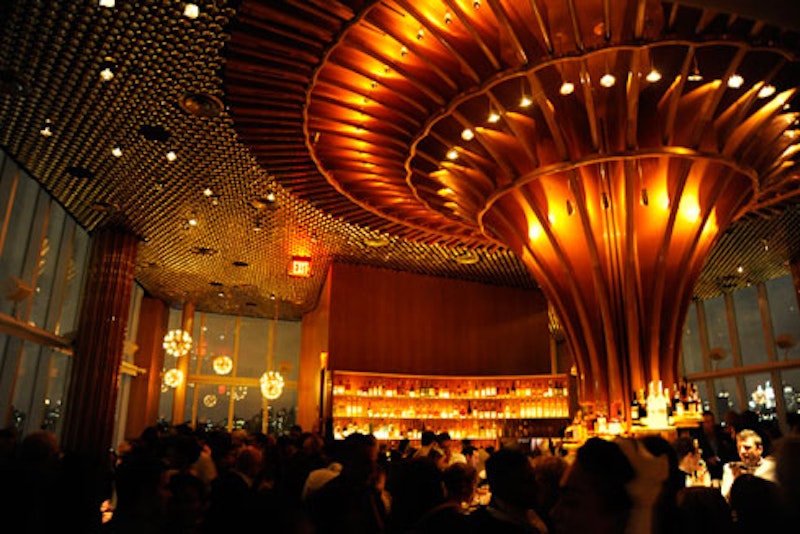This semester I had the great fortune of teaching a self-designed seminar at Yale that you may have heard about. “Dance Music and Nightlife Culture in New York City,” as the American Studies Junior Seminar was called, addressed the cultural history of nightlife from a largely theatrical perspective. I’ve never had such a captivated, engaged, and thoughtful audience. We listened to and analyzed some great dance music; spent time in the Yale Beinecke Rare Book and Manuscript Library and looked at party flyers from Danceteria, the famous 1980s New York club. We even got to peep some of the Harlem “rent party” cards that the African-American poet Langston Hughes collected in the 1920s and 30s, some of which—amazingly—were actually handwritten. From there, we talked about nightlife as a multi-billion dollar industry; we theorized the meaning and staying power of nightlife as it relates to regulation, darkness, sexuality, and intimacy; and, yes, we went to the Boom Boom Room.
For better or worse, the media is already fascinated by what’s going on at “HYP,” which would spell “hype” if you just added an “E,” so the second they hear about a Yale “class,” as some folks put it, on nightlife that had guest speakers like Simonez Wolf, Cody Allen, Andrew WK, Cherie Lily, Scott Poulson-Bryant, and guest DJs Gavin Royce and Chris Alker, out come the fangs. Most of the news coverage about the course—including our stint on NPR’s “Wait Wait Don’t Tell Me” last Saturday morning—had to do with mocking Universitatis Yalensis and pointing out the “ridiculousness” of paying a $50,000 cover charge to go to a magical university just to study something as apparently inconsequential as nightlife. Why study culture when the job rates are low? How good is a nightlife class going to look on your resume? And, by the way, who needs theater studies, African-American studies, and, god forbid, women’s studies when math, science, and engineering are clearly the only useful, worthwhile subjects of study?
You know what I say: there’s no such thing as bad press! But the one thing that consistently bothered me about the news coverage was how grossly misinformed it was. Virtually none of the bloggers who wrote about the class, aside from the amazing original story that appeared in the New York Post’s “Page Six,” actually bothered to contact me for clarification. Nobody asked to see a syllabus. Nobody emailed to find out more about what we were doing.
Isn’t that just bad journalism? Aren’t reporters supposed to consult three sources or at least do a quick fact check before they run a piece? Is it news if sources merely cite and “spin” what other news sources have already said? And what if that stuff is wrong? Then where’s the story?
The bad journalism aside, I’m not even bothered by questions about the validity of nightlife as a serious subject of intellectual inquiry. Most objections to nightlife have to do with the perceived decreasing importance of the humanities—look at what those silly cultural studies people are doing! Or if not that, then it has to do with people’s morals and judgment about actually going out to the club and being interested in club life, which people easily associate with hooking up, drugs, and alcohol. My aunt Jackie, a Jesus fanatic whom I love to death, used to warn my cousin and me: “Now ya’ll betta stay away from them clubs. That’s the devil’s house.” I think that pretty much sums it up.
Look, the fact is that every creative group that’s ever existed has had a nightlife. Every office has a happy hour to take our minds off the drudgery and boredom of work. Nightlife, like a good two-hour movie, provides an escape from things. And though it is tied to industry like so many other creative fields including art, music, and fashion, I see nightlife as an art form in its own right.
Nightlife can be thought of as a social sculpture. There’s a real artistry that goes into pulling a crowd together and getting that crowd to interact with one another through music. How else does a promoter know which space to use, which DJs to hire, the right way to design a flyer, the proper lighting, and the specific type of music to play that will get you there and keep you there and having fun for hours on end? The way I see it, these are the sculptural qualities of nightlife, and part of what keeps it interesting.
But let’s just stick to the facts: anyone who doubts nightlife as a worthy intellectual pursuit should know that in 1925, even The New Yorker, the highest of the brows, hired the fabulous flapper Lois Long to inaugurate its first nightlife column, which did much to get the magazine off the ground. Now if The New Yorker isn’t intellectual, I don’t know what is.

